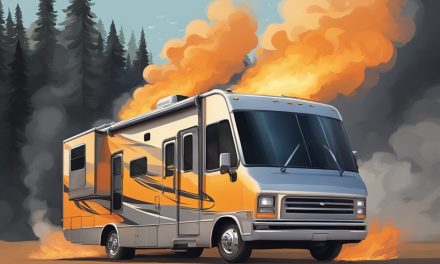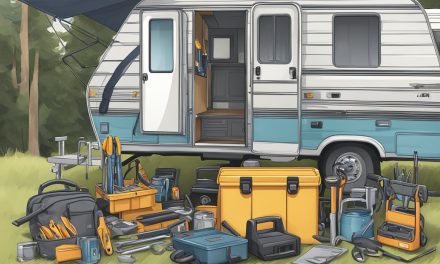Would you like to save this article?
RV dreams can quickly turn into nightmares if you don’t know what you’re walking into. The recreational vehicle industry ships over 313,000 units annually, but behind those glossy brochures and happy camper marketing lies a complex web of quality issues, warranty loopholes, and legal gray areas that can leave you holding the bag.
In a candid interview with RV lemon law attorney Beth Wells, who has over 20 years of experience fighting for frustrated RV owners, some eye-opening truths emerged. With 11.2 million American households owning RVs and another 9.6 million planning to buy by 2026, these insights could save you from becoming another cautionary tale. The stakes are higher than ever—the North American RV market is worth nearly $20 billion and growing rapidly.
Whether you’re dreaming of weekend getaways or full-time RV living, understanding these industry secrets before you make that purchase could be the difference between living your best life and living in RV purgatory. You deserve to know what dealers and manufacturers don’t want to tell you.
1. Dealers Can Legally Wash Their Hands of Everything
Here’s a truth that’ll make your wallet weep: most RV dealers include disclaimer language in purchase agreements that releases them from ANY warranty responsibility. Yes, you read that right. While you’re focused on financing terms and delivery dates, buried in the fine print is language stating the dealer accepts zero responsibility for defects, implied warranties, or merchantability issues.
Attorney Beth Wells confirms this harsh reality: “For the dealer, yes, they can disclaim their implied warranty… some states they may not be able to, but I know in Ohio they can.” This means when your brand-new $100,000 motorhome starts leaking water through improperly sealed AC units (a real case Wells described), you can’t hold the dealer accountable even if they failed to catch obvious problems during their pre-delivery inspection.
The numbers don’t lie: According to industry data, Forest River alone averages 50 recalls per year, many stemming from basic manufacturing errors that should be caught during dealer inspections. Yet dealers routinely push RVs off their lots without thorough checks, knowing they’re legally protected.
Here’s the kicker: You’re probably thinking, “But they told me they did a complete PDI (Pre-Delivery Inspection)!” Unfortunately, verbal promises don’t override written disclaimers. If a dealer makes specific verbal representations about inspections or repairs, those statements can be legally binding—but good luck proving what was said versus what’s written in your contract.
2. Your RV Might Be Suffering from “Lot Rot” Before You Even Drive It
Picture this: You find the “perfect” RV at a great price, and the salesperson mentions it’s been on the lot for a year or two. What they don’t tell you is that your “new” RV has likely been deteriorating while sitting exposed to the elements—a phenomenon the industry calls “lot rot.”
Wells explains the hidden timeline problem: “If there was a good bit of time, like even maybe more than a year between when it was first delivered to the selling dealer and when it was actually sold, you’re likely to have issues.” She routinely sees cases where RVs sat on dealer lots for 12-24 months without proper maintenance.
The maintenance reality is sobering: While manufacturers require dealers to perform periodic maintenance on unsold units—checking seals, running systems, preventing weather damage—many dealers skip these steps to save money. Wells notes that manufacturers like Numar will approve second PDIs for units that have been sitting, but dealers must request and wait for approval before getting paid for the work.
Here’s what you can’t see: That pristine-looking RV might have compromised seals, dead batteries, deteriorated rubber components, or even missing parts that were “borrowed” for other units. Industry insiders report that parts are sometimes removed from lot units to complete other sales, with promises to replace them later that don’t always get fulfilled.
3. The Industry Prioritizes Speed Over Quality (And It Shows)
Want to know why your brand-new RV feels like it was assembled by caffeinated squirrels? The entire industry operates on a piece-rate payment system that rewards speed over craftsmanship. Workers are paid by the unit, not by the hour, creating a perverse incentive to rush through assembly.
Recent Wall Street Journal investigations revealed shocking examples: Workers punctured microwaves with incorrect-length screws, misaligned furnace flues went unnoticed for a month after the inspector quit, and 50 towable campers were recalled after workers installed wrong fuses in power distribution centers simply because the factory ran out of correct fuses.
The labor market reality is even worse: Many RV workers in Elkhart (which produces 84% of all North American RVs) work two jobs. Industry insiders report that workers often start before sunup, rush to complete their quota, then leave for afternoon jobs elsewhere. When you’re sleep-deprived and racing against the clock, quality suffers.
Wells sees the evidence firsthand: “I don’t think I’ve ever seen a build record produced in Discovery where every single item was initialed” on shortage lists—documents that track missing parts and needed repairs. These shortage lists are supposed to ensure every problem gets fixed before the RV leaves the factory, but workers routinely skip signing off on completed items.
4. Water Damage Is Your Worst Enemy (And Nobody Wants to Fix It)
If there’s one thing that’ll turn your RV dream into a mold-infested nightmare, it’s water intrusion. Wells describes water damage as “one of the worst things that can happen” to an RV, and manufacturers have figured out creative ways to avoid dealing with it properly.
Real case example: Wells handled a case where a destination trailer was sold with unsealed AC units that leaked during the first rainstorm. The dealer’s response? “Go ahead and clean the water up. We’ll send somebody out to fix it.” But water damage doesn’t just disappear—it creates hidden mold problems in walls that won’t be discovered until months or years later.
The manufacturer response is predictable: They’ll fix the immediate leak but refuse to investigate potential water damage. Wells explains: “I’ve seen just in my experience in my cases that it’s really hard for dealers to get manufacturers to do anything other than like fix the issue that was causing it. Not really dig in to see if there’s water damage.”
Here’s your defense strategy: Buy a moisture meter for $30-40 on Amazon. Industry experts swear by these devices for detecting hidden water problems. These RVs leak more than you’d suspect, often in places you’d never think to check. Don’t accept “that’s just how RVs are” as an answer—water intrusion in a new unit is absolutely unacceptable.
5. The Lemon Law Maze Varies Wildly by State
Think lemon laws work the same everywhere? Think again. There’s no federal RV lemon law, and state protections vary dramatically. Some states don’t cover RVs at all under their lemon laws, leaving you with only federal Magnuson-Moss Warranty Act protections.
The 153-day rule sounds simple but isn’t: Most lemon laws require either multiple repair attempts for the same problem OR 153 days total out of service during the warranty period. But here’s the catch—dealers have figured out how to game this system.
Warranty language is getting sneakier: Some dealers now include language in repair orders stating that time spent waiting for parts counts as “storage time,” not repair time. This means your RV could sit broken on their lot for weeks or months, but only the few hours of actual labor count toward the 153-day limit.
Wells reveals the industry tactic: “Even if it’s a defect that keeps you from even being able to use the RV… they say, ‘Look, you know, it only took us eight hours to fix it, but it took three weeks to get the part in.'” That whole three-week period won’t count as loss of use under newer warranty language.
The legal reality: Most RV warranties specify that Indiana law applies regardless of where you live, since that’s where most RVs are manufactured. This means understanding Indiana’s specific lemon law protections is crucial for all RV buyers.
6. Structural Problems Are Becoming More Common
While most people worry about appliances and plumbing, Wells is seeing an alarming increase in structural warranty claims—the kind of problems that can render an RV completely unusable and unsafe.
The warranty timeline matters: Structural warranties typically last 3-5 years versus the standard 1-year limited warranty on other components. This means Wells can sometimes help owners whose basic warranty has expired but who are experiencing frame, chassis, or structural integrity problems.
What constitutes structural damage? We’re talking about broken frames, roof structural failures, wall separation, and foundation problems—issues that go beyond simple repairs and potentially make the RV unsafe to inhabit or tow.
The financial impact is devastating: Unlike a broken fridge or faulty slide-out, structural problems often require complete rebuilds or total loss declarations. These are the cases where owners discover their “dream home on wheels” is actually a money pit on wheels.
Industry connection: The increase in structural problems correlates with the post-COVID production rush, when manufacturers prioritized speed and volume over quality control. Many of these structural issues are now emerging as RVs age past their initial warranty period.
7. Your Best Defense Is Slowing Down and Reading Everything
The most powerful weapon against RV industry shenanigans isn’t a lawyer—it’s your willingness to slow down, read contracts thoroughly, and refuse to be rushed through the process. Most RV disasters happen because buyers got caught up in the excitement and skipped crucial steps.
Pre-purchase inspection is non-negotiable: Wells strongly recommends third-party inspections: “I would say probably doing one of those pre-sale inspections is a good idea. A lot of those people tend to be very detailed, so they’re going to find things even that might not even be a huge deal to you.”
The signing sequence matters: Never sign purchase documents before completing your final walkthrough. Wells confirms this approach: “I wouldn’t agree to purchase something that I hadn’t inspected for sure.” Many buyers get trapped by signing loan papers first, then discovering problems during walkthrough when it’s too late to back out.
Contract modifications work (sometimes): You can cross out problematic warranty language, and Wells suggests it might be worth trying: “I wonder if you cross it out… Is the person logging that warranty form really going to care? And I wonder if that would even impact your warranty moving forward.”
| Critical Pre-Purchase Checklist |
|---|
| ✅ Independent third-party inspection |
| ✅ Moisture meter testing for water damage |
| ✅ Complete systems testing (slides, appliances, etc.) |
| ✅ Review all warranty paperwork before signing |
| ✅ Cross out problematic disclaimer language |
| ✅ Document any dealer promises in writing |
| ✅ Check manufacturing and lot arrival dates |
Your purchasing power is strongest before you sign. Once those documents are executed, you’re playing by the manufacturer’s and dealer’s rules. Take your time, ask questions, and be prepared to walk away if something doesn’t feel right.
SOURCES
- RV Wingman YouTube Channel – “Before You Buy an RV, Watch This First”
- ConsumerAffairs – RV Industry Statistics 2025
- RV Lifestyle – Industry Exposed For RV Quality Problems
- Wall Street Journal – Warren Buffett Hasn’t Fixed the RV Industry’s Serial Breakdowns
- RV Industry Association – RV Shipments and Industry Data
- Consumer Affairs – Forest River RV Recalls
- Roamly – RV Brands to Avoid Quality Issues





